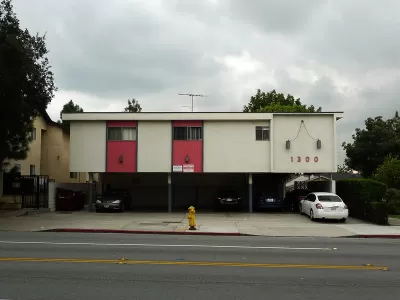The low-slung, car-oriented apartment buildings represent a mid-century solution to a housing shortage and offer valuable lessons for new development.

Describing the "aggressively economical" icon of mid-density apartment buildings known as dingbats that pepper Los Angeles from the Valley to the Eastside, Laura Bliss writes that these buildings "were a multifamily answer to that single-family template." These two- to three-story buildings include a carport on the bottom level and generally house six to 12 units. In the 1950s and 1960s, "[t]his new format for affordable multifamily living became nearly as ubiquitous as the single-family tract housing that iconified the much-mythologized Southern California suburban lifestyle."
Dingbats provided "an essential resource for a growing city: Los Angeles County added more than three million residents between 1940 and 1960, thanks to job booms in manufacturing and aerospace, educational opportunities for returning GIs, and the lure of year-round sunshine." Over 700,000 new units sprawled outward as new freeways made the periphery more accessible and the city swallowed up citrus orchards and ranches.
Today, dingbats, many of which are rent-stabilized, offer some important benefits as "a bastion of relatively affordable shelter" in a city facing a severe housing shortage. "Dingbats may also hold the possibility for accommodating further infill: Thanks to recent legal changes, it’s now possible to convert carports into accessory dwelling units, which some owners are beginning to do." These buildings exemplify the mid-century's answer to "missing middle housing" and "tell a story of when the city met the demands of the day with a low-cost, replicable, yet individualized housing form factor."
FULL STORY: How Los Angeles Became the City of Dingbats

Planetizen Federal Action Tracker
A weekly monitor of how Trump’s orders and actions are impacting planners and planning in America.

DARTSpace Platform Streamlines Dallas TOD Application Process
The Dallas transit agency hopes a shorter permitting timeline will boost transit-oriented development around rail stations.

Congressman Proposes Bill to Rename DC Metro “Trump Train”
The Make Autorail Great Again Act would withhold federal funding to the system until the Washington Metropolitan Area Transit Authority (WMATA), rebrands as the Washington Metropolitan Authority for Greater Access (WMAGA).

Supreme Court Ruling in Pipeline Case Guts Federal Environmental Law
The decision limits the scope of a federal law that mandates extensive environmental impact reviews of energy, infrastructure, and transportation projects.

Texas State Bills to Defund Dallas Transit Die
DART would have seen a 30% service cut, $230M annual losses had the bills survived.

Bikeshare for the Win: Team Pedals to London Cricket Match, Beats Rivals Stuck in Traffic
While their opponents sat in gridlock, England's national cricket team hopped Lime bikes, riding to a 3-0 victory.
Urban Design for Planners 1: Software Tools
This six-course series explores essential urban design concepts using open source software and equips planners with the tools they need to participate fully in the urban design process.
Planning for Universal Design
Learn the tools for implementing Universal Design in planning regulations.
Roanoke Valley-Alleghany Regional Commission
City of Mt Shasta
City of Camden Redevelopment Agency
City of Astoria
Transportation Research & Education Center (TREC) at Portland State University
US High Speed Rail Association
City of Camden Redevelopment Agency
Municipality of Princeton (NJ)





























